Rag-Fork For removal of, among other things, Ragwort
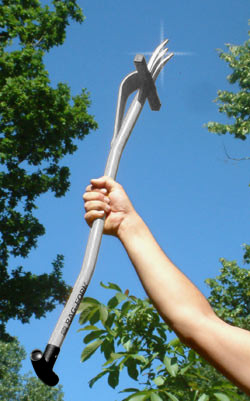
The Ultimate Control of Ragwort
- What is it?
- How does it work?
- The Advantages
- Practical Tips
- New, Improved Version!
- Our Own Experience
- Order Now
What is it?
You're probably aware of the dangers of Ragwort. (If not, please check our page about ragwort) It's a plant you certainly don’t want in your pasture, but if it does manage to take hold, you'll know how difficult Ragwort is to remove. The plant is essentially immune to pesticides, mowing frequently isn’t a viable option, so manual removal is essentially the only solution.
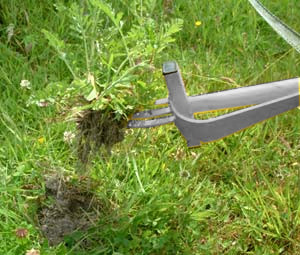
However, the plant is very firmly rooted, and if you pull too hard, the stem breaks leaving the roots behind, meaning the plant will quickly return. This battle with the toxic Ragwort can drive pasture managers to despair.
Thankfully, there is now a practical solution: the Rag-fork!
The Rag-fork has been specifically developed to easily, quickly, effectively, and permanently remove Ragwort, roots and all. No more tugging, no more stems breaking, no more roots left to facilitate the return of this yellow menace. The Rag-fork was developed in England, where they have been dealing with Ragwort for a longer time. (In England, this plant is called Ragwort, hence the name Rag-fork.)
While the Rag-fork is specially designed to fight Ragwort, it also proves highly effective in removing other weeds. We use it successfully and with great satisfaction to uproot sorrel and thistles.
How does it work?
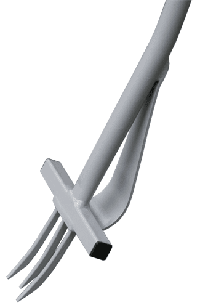
The Rag-fork is a clever design. The three prongs are precisely spaced to minimize root damage while also providing sufficient upward force to lift the plant from the ground. By using the footrest, you can effortlessly insert it into most soil types, and with the handle lever at the back, you gain leverage when tilting the handle backwards, making the plant come out without exertion. The remaining hole is surprisingly small; this is because the Rag-fork lifts the roots without raising the surrounding soil.
Here's how to use the Rag-fork:
- Place the Rag-fork on the ground just in front of the plant.
- Press it down with your foot.
- Tilt the Rag-fork backward.
- Rotate the Rag-fork slightly left or right if needed.
- Pick up the plant.
The Advantages
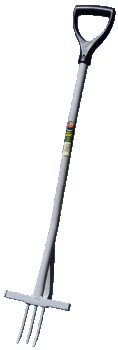
The advantages of the Rag-fork are:
- Environmentally Friendly. The Rag-fork doesn't harm the environment with toxins and does not disturb the soil life.
- Lightweight. The Rag-fork is lightweight with handy dimensions, allowing you to carry it as you walk into the field, ready to remove any Ragwort you may come across. In England, it’s even used as a walking stick.
- Easy to Use. The Rag-fork makes removing Ragwort an easy task requiring minimal effort. It's suitable for both young and elder pasture managers.
- Effective. The Rag-fork is the most effective and eco-friendly weapon against Ragwort.
- Suitable for Other Weeds. Initially designed for Ragwort, it also proves effective against thistles, sorrel, and other pasture weeds.
- Lifetime Warranty. Purchase a Rag-fork once and benefit from it for a lifetime.
Practical Tips
Here are some practical tips for controlling Ragwort using the Rag-fork:
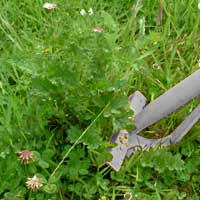
- If the plant is too big to remove in one go, reposition the Rag-fork around the plant, lifting it from different angles until it releases easily. Avoid pulling hard as this may break small pieces of the root.
- Immediately remove any plants you pull up! Once uprooted, the plant is no longer recognised by horses as toxic and can be appealing to eat.
- "A cornered Ragwort makes strange sprout!" The plant is known to make a last-ditch effort to produce seed just before dying. Do not be surprised to find the plant "in fluff" a few days after pulling it out. If you want to be certain, burn the plant or dispose of it in a sealed plastic bag.
- Ragwort produces seeds that germinate quickly and others that take years to do so. If you've had Ragwort in your pasture, you'll need to monitor the pasture for years. Missing one year can result in being "back to square one."
Our Own Experience
Due to our webpage on Ragwort, we receive many inquiries about solutions against Ragwort. We've done extensive experimentation without finding a truly good solution. Chemical treatments (growth hormones) don’t work well on Ragwort; many plants survive. Last year, we treated plants with hormones, which eventually killed some, but not all, and it took a long time. Pulling them out by hand was an illusion, too. We had a few meters along the track where Ragwort flourished, and despite pulling them all out by hand, roots and all, we ended with terrible back pain and yet the same stretch was full of Ragwort again this year.
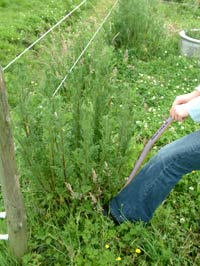 |
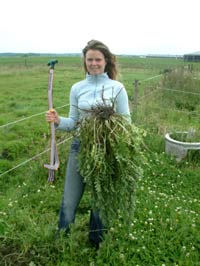 |
|
|
The Rag-fork is not only suitable for small rosettes but also handles mature specimens effectively! |
||
Since England has been combating this weed for a long time, we looked for a good solution there. We first saw the Rag-fork two years ago, but we were stubborn, thinking a small spade and our hands could manage just as well. After learning from experience last year that this wasn’t true, we asked our contacts in England about their experiences with the Rag-fork. They confirmed that they've managed to clear their land of Ragwort completely using it. The weed was truly gone for good.
That prompted us to try the Rag-fork last year, and it turned out to be much better than expected! Everything was super easy to remove, beautifully extracting the roots as well. Large thistle bushes towering over me (+1.75m) could be removed without even touching them and without straining my back inappropriately. The Rag-fork isn’t just a solution for Ragwort, but also works wonders on other weeds, with no strenuous effort and without chemicals.
The best part is knowing that the effort isn't in vain, as the uprooted plant won’t return next year. And ultimately, that’s what it’s all about: a definitive solution for Ragwort.
Order Now
| Er ligt nog niets in je winkelwagen. |